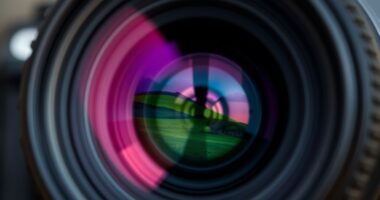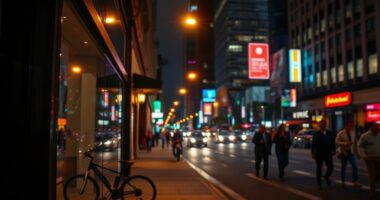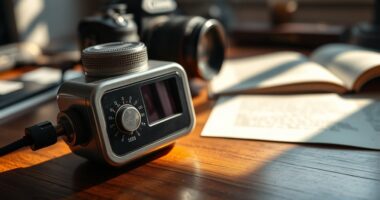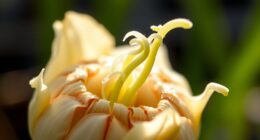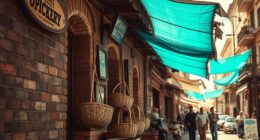To turn city traffic into abstract art with long-exposure light painting, you’ll need a sturdy tripod and a camera set to low ISO and narrow aperture. Keep the shutter open for several seconds or minutes to capture the movement of headlights, taillights, and neon signs, creating vibrant light trails and motion blur. Experiment with different exposure times and compositions to turn chaotic traffic into mesmerizing patterns. Explore more techniques to elevate your urban light paintings.
Key Takeaways
- Use a sturdy tripod and slow shutter speeds to capture continuous light trails from moving vehicles.
- Incorporate neon city lights and light sources to enhance vibrancy and create dynamic abstract patterns.
- Experiment with different exposure durations to control the length and intensity of light trails and motion blur.
- Compose scenes with curved roads or intersections to guide the eye and add visual interest.
- Adjust camera settings—low ISO, narrow aperture—to prevent overexposure and highlight the colorful light effects.

Long-exposure light painting is a mesmerizing photography technique that transforms simple scenes into vibrant works of art. When you master this method, you can turn everyday city traffic into stunning abstract compositions filled with energy and color. By capturing the movement of headlights and taillights over an extended period, you create a dynamic scene that seems to pulse with life. The neon glow of city lights becomes a swirling backdrop, adding an otherworldly feel to your images. The key to this effect lies in controlling the exposure time, allowing the camera to record motion blur and light trails that would be invisible to the naked eye.
Master long-exposure photography to turn city traffic into vibrant, abstract light trails and dynamic urban art.
As you set up for long-exposure shots, you’ll want a sturdy tripod to keep your camera steady while everything else moves. Once you frame your shot, adjust your camera to a low ISO setting and a narrow aperture to avoid overexposure. When the shutter remains open for several seconds or even minutes, the moving cars produce streaks of light that stretch across the scene. These streaks, or light trails, form patterns that resemble abstract art. The neon glow from street signs, storefronts, and vehicle lights adds vibrancy and contrast, making your photo more enthralling. The motion blur from moving vehicles creates a sense of speed and chaos, turning a busy street into a swirling canvas of color and motion.
You’ll notice how the motion blur emphasizes the movement, giving your shot a sense of rhythm and flow. The longer the exposure, the more pronounced the trails become, transforming the chaos of city traffic into a harmonious pattern. To get the best results, try experimenting with different shutter speeds; shorter exposures will capture less movement, while longer ones will exaggerate the trails. Incorporate elements such as curved roads or intersections to guide the eye through your composition, and aim for locations where traffic is consistent but not overwhelming. This way, you can achieve a balanced scene where the neon glow and motion blur work together to create a mesmerizing abstract art piece.
Additionally, understanding how to maximize space and organization in your gear and setup can streamline your workflow and improve shot efficiency. With patience and practice, you’ll discover how to harness the energy of city traffic, turning it into a compelling visual story. Long-exposure light painting invites you to see the city’s chaos as an opportunity for creativity, transforming ordinary moments into extraordinary images. As you experiment, you’ll learn how to control light trails, enhance neon glow effects, and craft compositions that showcase motion blur’s artistic potential. This technique offers endless possibilities for expressing the vibrant pulse of urban life, all through the magic of long exposure.
Frequently Asked Questions
What Camera Settings Are Best for Light Painting?
To get great light painting shots, you should experiment with your camera aperture and ISO settings. Use a small aperture (like f/8 or higher) to keep more of the scene in focus, and set your ISO to a low value (such as 100 or 200) to reduce noise. Combine these with a slow shutter speed to capture light trails, and don’t forget to stabilize your camera with a tripod for sharp results.
How Do You Choose the Right Location for City Traffic Light Painting?
Think of choosing your location as selecting the canvas for your urban masterpiece. You wanna find a spot with a dynamic backdrop that highlights the movement, like a busy intersection or a bridge. Look for an area with minimal light pollution and interesting structures. Your light source selection should complement the environment, so pick a spot where the city’s energy amplifies your light painting’s abstract story.
Can Smartphone Cameras Be Used for Long-Exposure Light Painting?
You can definitely use smartphone cameras for long-exposure light painting, but be aware of smartphone limitations like sensor size and stability. To get better results, use apps with manual controls for exposure and ISO adjustments, which enhance your capabilities. Keep your phone steady with a tripod or stable surface, and experiment with different exposure times. These app enhancements help you create striking abstract city traffic art with your smartphone.
What Safety Precautions Should Be Taken During Night Photography?
When doing night photography, you should prioritize traffic safety and pedestrian awareness. Always stay in well-lit areas, avoid obstructing traffic flow, and wear reflective clothing if you’re near roads. Use a tripod to stay steady and avoid sudden movements that could cause accidents. Stay alert, watch for moving vehicles, and don’t distract drivers. Being cautious helps you capture great shots without risking your safety or others’ during night shoots.
How Do Weather Conditions Affect Long-Exposure Light Painting?
Weather impact can dramatically alter your long-exposure shots, making atmospheric conditions seem like a storm of chaos or calm. Rain, fog, or wind can blur or distort your images, or even damage your gear. You need to protect your camera and understand how weather affects light trails and colors. Adjust your settings accordingly, and embrace the unpredictable, because nature’s mood can turn your photos into breathtaking masterpieces.
Conclusion
As you watch city traffic blur into vibrant streaks, you realize how light transforms chaos into art. The busy streets, once overwhelming, become a canvas of abstract beauty through your lens. In this dance of fleeting moments and steady exposure, you find tranquility amid motion. Long-exposure light painting turns the everyday rush into a striking masterpiece, reminding you that even in chaos, there’s artistry waiting to be captured—if you just look closely enough.


